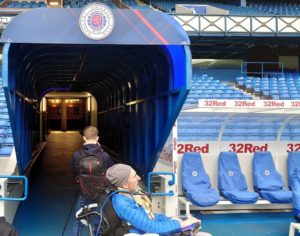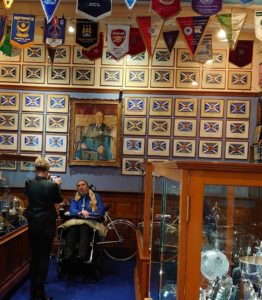That’s not correct – it’s a hospital but I thought it might encourage you to start reading. Until last week, over the nine months I have been in the spinal injuries unit here in Glasgow, I’ve been out once, with my brother to Kelvingrove Park. The nursing staff here have pointed out that I may be running the risk of “institutionalisation” – basically the idea that I could become more at home in the hospital than in my own home. It’s difficult not to love the nurses here, with whom I spend a great deal of time. The spinal injuries unit seems to me to be a really effective team with more than the average sprinkling of perfectionists. I do find the thought of a “cliff edge” end to some valued relationships a bit daunting. Doubtless this will be replaced by a new set of relationships with my care team (still to be hired..). Anyway, always willing to listen to advice, two visits (yes 2!), were organised last week. Firstly, with my summer cycling old geezers and my sister to a nearby pub. Secondly, with a couple of other patients and two nurses to Ibrox Park, home ground of Rangers football club. There were plenty of “learning points” – the first being that I should read the fine print and really understand what I had signed up for on any outing. Some additional thought to what would be required to drive a 25 stone wheelchair on and off a minibus with me perched on top might also have been prudent. I did survive both trips, not without a few hairy moments, and so the de-institutionalisation process has begun.
First, the pub. The NHS is being sued by its loving patients for around £2 billion each year. As a result, it now takes risk assessment very seriously. (I’d like to write about this in a future blog but some research is required). To be honest, it seems to have got rather excessive so that procedures I could line up myself outside the hospital are deemed too risky inside. Enter the hospital minibus partnered with a 25 stone wheelchair with me on top. A narrow ramp is required to load me incurring a risk (in my view) somewhat greater than a wee electrical tickle to my forearm (judged too risky). After a couple of aborted attempts to drive up the ramp I handed over the controls to a more competent driver. My cycling friends and sister were waiting and lunch was great fun and very enjoyable at the Steam Wheeler pub. I’m not sure how far I have really accepted my injury so activities like this help me on this path. I avoided tears, but it was quite emotional to get together around the table again. Preparations for 2020 are progressing without me on Monday nights in an Edinburgh pub. Here’s a link to my last outing in 2018 from Amsterdam to Majorca. https://vimeo.com/276492561
Second, Ibrox Park – home to “the world’s greatest football club” organised by one of my fellow patients. Whilst fans of other clubs might dispute this claim, there’s no question that the club has some huge achievements behind it and plays in a stadium with an iconic building forming part of the main stand, scene of triumph and tragedy. Despite being built only 11 years after the end of the Great War, navigating the press room, trophy room, manager’s office and changing rooms, is quite difficult in a modern NHS powered wheelchair. I have to admit to being pretty tired by the end of the visit and would not have made it over the finish line without the expert hands of one of our male nurses to navigate some tight corners and reverse into lifts not really designed for the purpose. Having said all this, for any sports fan it’s a great visit led by a knowledgeable and engaging guide and finished off with a really excellent lunch in the Govan Stand. More than any British city, Glasgow seems to be defined by its football teams and their fanatical supporters (and religious allegiances). Whilst the atmosphere at premiership matches appears increasingly tame, the 50 or 60,000 at Ibrox or Celtic Park for an “Old Firm” game remind us what a real old-fashioned football atmosphere was like. I could have opted for a green or blue flash along the side of my wheelchair but chose a neutral black as a safety precaution. I don’t think my English friends really are a believe any of this until they visit.
Dos días fuera del manicomio
Hola John,
please see the edited Spanish below (and attached).
Sorry to keep this short, I am horribly late this morning – blame the church bells for misleading me, after my alarm went off at 7 I was waiting for the 7.15 chime to get up, but it never happened and I fell back to sleep!
😉
Cheers
Fran
Dos días fuera del manicomio
No es correcto, en realidad es un hospital pero pensé que podría darte más ánimo para empezar a leer. Hasta la semana pasada, durante los nueve meses que he estado internado en la unidad de lesiones espinales aquí en Glasgow, he salido del hospital una sola vez, con mi hermano al parque Kelvingrove. El personal de enfermería me hizo notar que podría estar corriendo el riesgo de “institucionalización”, o sea, básicamente la idea de que podría sentirme «como en casa» más en el hospital que en mi propria habitación. Es difícil no amar a las enfermeras aquí, con ellas paso mucho tiempo. La unidad dedicada a las lesiones de la columna vertebral me parece un equipo realmente eficaz, con un toque de perfeccionismo superior a lo normal. Encuentro desalentadora la idea de que una relación tan inestimable pueda terminar al «borde del precipicio». Sin lugar a dudas, estos contactos serán sustituidos por una nueva serie de relaciones con el personal de mi nuevo equipo de asistencia (que todavía tengo que contratar…). De todos modos, siempre dispuesto a escuchar consejos, la semana pasada organizaron para mí dos visitas (¡sí 2!). La primera, con mis viejos amigos ciclistas, con los que salía a correr en verano, que vinieron junto con mi hermana y nos encontramos en un pub aquí cerca. La segunda, con un par de pacientes y dos enfermeras al parque Ibrox, la sede del club de fútbol Rangers. Había un montón de cosas por aprender, la primera era que debía leer bien toda la letra pequeña y entender realmente a qué me había apuntado en cada salida. Hubiera sido prudente también pensar a lo que servía para subir y bajar una silla de ruedas de casi 160 kg de un minibús conmigo encima. Sobreviví a ambos viajes, no sin algunos momentos que me pusieron los pelos de punta… y así comenzó el proceso de desinstitucionalización.
Primera salida: el pub. Cada año el Servicio Nacional de Salud es citado en juicio por sus cariñosos pacientes por unos 2 mil millones de libras esterlinas. Por consiguiente, la evaluación de riesgos ahora se toma muy en serio. (En futuro, me gustaría escribir una entrada sobre este tema, pero tengo que investigar bastante). Para ser honestos, me parece más bien exagerado, porque las mismas acciones que podría hacer yo mismo fuera del hospital se consideran demasiado arriesgadas dentro del mismo. Entrar en el minibús del hospital con una silla de ruedas de unos 160 kg conmigo encima. Para cargarme se necesita una rampa angosta, lo que supone un riesgo (a mi parecer) algo mayor respecto a una pequeño cosquilleo eléctrico en el antebrazo (considerado demasiado arriesgado). Después de un par de intentos fallidos de subir por la rampa dejé los controles a un piloto más competente. Mis amigos ciclistas y mi hermana me estaban esperando en el pub Steam Wheeler, donde almorzarmos juntos, todo fue muy divertido y agradable. No sé hasta qué punto he aceptado realmente mi lesión, así que actividades como ésta me ayudan en este camino. Evité las lágrimas, pero fue muy emotivo volver a estar alrededor de una mesa.
Los preparativos para el 2020 están continuando sin mí, los lunes por la noche en un pub de Edimburgo. Aquí hay un enlace de mi última salida en 2018, de Ámsterdam a Mallorca. https://vimeo.com/276492561
Segunda salida: el parque Ibrox, la sede del «el club de fútbol más importante del mundo» organizado por uno de mis amigos pacientes.
Mientras que los aficionados de otros clubes podrían poner en duda esta afirmación, es evidente que el club consiguió enormes éxitos en los años pasados y juega en un estadio con un edificio icónico que forma parte de la tribuna principal, escenario de triunfos y tragedias. No obstante haya sido construido sólo 11 años después de la fin de la Primera Guerra Mundial, es bastante difícil visitar la sala de prensa, la sala de trofeos, la oficina del director y los vestuarios en una moderna silla de ruedas eléctrica puesta a disposición por el Servicio Nacional de Salud. Tengo que admitir que al final de la visita estaba bastante cansado y no habría podido completar el recorrido sin las manos expertas de uno de nuestros enfermeros, que me ayudó a maniobrar en algunas zonas angostas y dar marcha atrás en los ascensores que no están diseñados para este propósito. Dicho esto, para cualquier amante del deporte se trata una óptima visita guiada, acompañada por una guía experta y apasionada, que terminó con un excelente almuerzo en el puerto de Govan. Más que cualquier otra ciudad británica, Glasgow parece estar definida por sus equipos de fútbol y sus hinchas fanáticos (y por sus alianzas religiosas). Mientras que la atmósfera de los partidos de la Premier League parece cada vez más tranquila, los 50 o 60.000 en los parques Ibrox o Celtic para un partido de la “Old Firm” nos recuerdan cómo era un verdadero ambiente futbolístico en viejo estilo.
Habría podido optar por un flash verde o azul en la parte lateral de mi silla de ruedas, pero elegí un negro neutro como medida de seguridad. No creo que mis amigos ingleses crean realmente a todo esto hasta que no vengan a visitarme.


Great to hear you getting out and about. Maybe you'll be at the next Old Firm derby…?